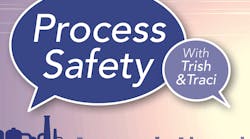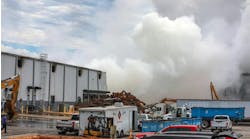Transcript
Traci: Welcome to Process Safety with Trish & Traci, the podcast that aims to share insights from past incidents to help avoid future events. I'm Traci Purdum, executive digital editor with Chemical Processing. And as always, I'm joined by Trish Kerin, the director of the IChemE Safety Centre. We meet once again, Trish, all in the name of safety. How have you been?
Trish: Yeah, not too bad. Thanks, Traci. I've been attending virtually the IChemE Hazards 31 Conference all week. So I've been doing all sorts of weird hours. I'm looking forward to a little bit of a sleep later today.
Traci: I bet. A lot of good stuff coming out of that?
Trish: Yes. Some really fascinating discussions about all different sorts of things. We spoke a little bit about some of the emerging hazards from new technologies, those sorts of things, but also a lot of focus still on culture and leadership, which is, as you know, one of my favorite areas to talk about. And there were certainly a lot of discussion about that over the last week.
Traci: Well, hopefully, we can get a couple of podcast ideas out of what you've learned this week. So that's good.
Trish: I think we will
Traci: In this episode, we're going to touch on a potentially sensitive topic, "Dumb Ways to Die." And I want to point out that we are not making light of fatal accidents. You and I had fleshed out this topic a while back after a friend of mine posted an image to Facebook at his workplace, he noted that the factory in which he works is always talking about safety initiatives yet they seem to miss the really big elephants in the room. In this case, it was pallets stacked way above a safe level and just waiting to come crashing down on someone. My suggested topic was along the lines of stupid safety traps. And then you turned me on to the Metro Trains Melbourne's "Dumb Ways to Die" safety campaign. Can you give us the cliff notes version of what that campaign was all about?
No worries! Subscribe and listen whenever, wherever.
Trish: Yeah, sure. So this campaign was launched several years ago now, and it was really aimed at trying to get people to realize that certain things they do around railway lines can have fatal consequences. And we need to be very careful about making sure that we don't get distracted around railway lines and inadvertently create issues. And just on your note, I'd also like to make it really clear that whilst the title of this campaign was Dumb Ways to Die and it was all a very catchy slogan, this is not about blaming the worker or blaming the person that is injured at all either. So that's an important thing to state here. This is about trying to make things safer, not about blaming anybody for getting injured or getting hurt, and certainly not about making light of fatal incidents. But it's about different ways to connect with different audiences to try and make sure that people start to become aware of what's going on.
The Dumb Ways to Die campaign had things like, you know, don't poke a grizzly bear with a stick, you know, don't eat medicines that are out of date, don't use a fork to get toast out of the toaster. But it also had things like, you know, don't block a railway crossing with your car in case the boom gates come down and a train comes through. Don't go running chasing after something on the platform and fall off. Make sure you've got the brakes of your pram or your pusher on, on the platform so it doesn't roll over into the train tracks. It had the train-related sort of things, but it also had some other, you know, fun things, don't take your helmet off in space. All sorts of different funny joke things that...they had these cartoon characters that portrayed each of these what they call dumb ways to die.
And, in fact, they even went as far as creating an app that had a game in it, and you could actually play dumb ways to die on this little app. And you had to try and, you know, basically avoid dying in all these different scenarios, whether it was the railway-related ones that were peppered through, or just the silly ones like, you know, poking a grizzly bear with a stick, as I'm sure speaking to people in North America, you wouldn't dream of doing that because that would really not be a very smart thing to do. So they had all those sorts of different activities.
Traci: Absolutely. Don't want to poke the bear for sure. But how effective was this campaign?
Trish: It's certainly got a lot of traction in people around the place. There were billboards everywhere, signs on all the stations, there were bright colors, they were cartoon characters. They grabbed your attention. I don't know the actual detailed statistics of whether there was a reduction in any incidents that occurred, but certainly, people talked about it. People knew about it. I knew a lot of people that had the game. In fact, I had the game, I used to play the game as I sat on public transport going to work. It was quite a fun little game to play on my phone. So it did have a lot of attention-grabbing to it. And I think that's what we sometimes see with safety campaigns that people go for attention-grabbing. There are different ways you can go for that.
In Victoria as well, decades ago now, we started to introduce some quite graphic television ads for road safety as well. And by graphic, I mean, you would actually see the person being run over and you would be the driver and you'd see them come through the windscreen at your sort of images. Incredibly graphic, real people being depicted in this way. And again, that was to create a shock value. Interestingly, that did drive down vehicle-related incidents, injuries, and fatalities. It had a very, very significant effect on how people portray...how people took in that information about road safety because it was really quite shocking. Now, other ads I remember, where they were in the rehabilitation hospital with the people that had been hit by cars or been in car accidents as well. And they were very emotive TV ads in that way. And in a similar way, the Dumb Ways to Die, they didn't have the graphic detail because they were cartoon characters that were dying and doing all sorts of weird things, but they did have...there was still the message there.
And it's all about how we portray the different messages. The big challenge with safety messaging is, though, that, for example, the really graphic TV ads for road safety worked with a certain portion of the population. And I've seen the equivalent graphic ads and posters in the workplace, you know, the hand with a finger missing and all those sorts of things. Not everybody sees them because some people choose to not see them. Some people will choose to look away. Some people will choose to change the channel on the television the moment that ad comes on because they're just too graphic for that person. It's not a one-size-fits-all. We actually need an entire suite of communication techniques to appeal to the different ways that people take in information and the different ways that will appeal to them. For some people, the cartoon character with a little bit of a laugh, but they might get the message. For others, they see the graphic ad and it really has a positive impact on them. But some see the graphic ad and just can't have anything to do with it. So we need to be very careful that we can't just only try one sort of communication. We need an entire suite to really broaden out the appeal so that it reaches everybody in the audience, not just some people.
Traci: Well, you make a good point. You know, thinking back to my childhood, I saw a cartoon that said about the fork in the toaster. And to this day, I always make sure that I have wooden tongs or I unplug the toaster. And that cartoon plays in my head. That’s 45-some years ago that I saw that. So that stuck with me and certainly those types of campaigns, you make the good point of you have to have different various ways to do it. I was researching accidents at facilities that might fall under the "Dumb Ways to Die" title. And there are quite a few from this year alone, from forklift accidents, to being in the path of a tote holding 330 gallons of liquid. Should chemical facilities launch their own jingles to help workers avoid really obvious but devastating accidents, their own jingles, or their own cartoons, or their own ways within their facilities to point out the major danger points?
Trish: I think there's a couple of different ways to approach this. First of all, go right back to the principles of safety. How is it that someone could possibly be in the same area that had tote being moved like that? So instead of talking about going straight to the safety jingle, let's talk about barriers. Let's talk about eliminating the hazard where we can. If we don't have the hazard there, the person can't get hurt regardless of how well we advertise what's going on in the workplace. We always need to really think about going right back to the hierarchy of controls. How can I eliminate this risk? If I can't eliminate it, can I substitute it? If I can't do that, how can I put engineering controls in place rather than getting all the way down to the PPE and the administrative controls only? You've got to start at the top of that hierarchy and work our way through it. We don't get to start at the bottom because the top is just a bit hard to do.
And that I think is one of the challenges that we've got, that we just sort of seem to focus only on really going to the administrative controls. They're important, but they're only administrative. We need to focus at the top end and we need to make sure that we do something about it. You know, I often hear people say, "Well, you know, you can't fix stupid." Well, actually, we shouldn't be putting people in a situation where they can end up doing something that's stupid that's going to result in them getting severely hurt or killed. What is it about the system? What is it about the workplace that makes it possible for that to go wrong? And why don't we design resilient workplaces where that doesn't happen? Where if someone makes a mistake, because let's face it, we're all human, we all make mistakes every day. If someone makes a mistake, it should not result in them or anyone else getting hurt. And if it does, then there's a fault in our system, not a fault in the person. People make mistakes. People also do amazing things to prevent incidents happening. So the human is not a bad thing in this, but the fact is that we do make mistakes, that's real life. So we need to make sure that when we make those mistakes, we're minimizing the risk to the person as much as possible in that scenario.
Traci: And you bring up a very good point of this isn't about the worker, this could potentially be about management making dumb mistakes. They're the ones making the dumb mistakes and not realizing that they don't have barriers around where a tote goes through. So maybe to take it to the hierarchy, like you say, and work its way down is a good approach that some facilities cannot even deal with.
Trish: Yeah. We need to be fixing the actual issues not trying to fix the worker. The worker doesn't need fixing, the system needs fixing. As I said, we need to communicate...we need effective communication techniques though. And in one job I had, we actually did have a safety mascot in the company. And when I first started as a safety manager, I looked at the safety mascot and I went, "I think we need to redesign that mascot," because the mascot was a superhero. And I thought sending the message that our workers were superheroes was perhaps not the right safety message to be sending. That was somewhat concerning to me. I didn't want people to think they were bulletproof because they're not. We ended up recreating this mascot and the mascot was always dressed in full PPE. We actually had little figurines of the mascot and we had a couple of costumes as well. Wherever we were in the country, the mascot could actually turn up and talk to the workers and talk about what was happening from a safety perspective.
We used it to communicate to the children of the workers as well because we had calendar coloring competitions every year and those sorts of things. Getting people to take safety home with them, getting it to be part of their lived experience every day. And it was actually a really quite a successful strategy that we ran. And what we did with these figurines was we said to the entire workforce, every time we catch you doing the right thing, every time we see you making something positive from a safety perspective, you know, following the process correctly, working well, we'll give you a little figurine. And they became very popular and people were really making efforts to get them because, especially if they had kids, then if they had multiple kids, they needed multiple figurines. And, you know, we then extended it to take the figurine on holidays with you and send us photos of where you are. And we then had this photo competition of this little safety mascot turning up in all sorts of different places. I think my favorite was on a gondola in Venice, but...so we had all these different little things happening.
And what it was it was just keeping safety in people's minds. So it was keeping it active, but it was fun. And it's okay to have fun in safety. It is serious work that we do... There's a very important quote from the Piper Alpha Investigation. And it goes something along the lines of, "Safety is not an intellectual exercise to keep us occupied. The sum of our actions determine whether the people we work with live or die." And that's from Sir Brian Appleton. And that is a real issue. The sum of our actions in the workplace do determine whether the people we work with live or die. Safety is a serious issue. But that doesn't mean we can't use fun and humor to engage people, to get them to remember things, and to bring them along on the safety journey. It doesn't have to be boring. It can actually be a little bit fun while still being serious.
Another example is in New Zealand are famous for their in-flight safety videos. If you've ever seen an Air New Zealand inflight safety video, they have a theme each time they create one. So obviously, Lord of the Rings was filmed in New Zealand, there's a Lord of the Rings safety video that they have. And so you can actually...they're all played by the actual characters, the actual actors that were in Lord of the Rings. And so where there's a little elf, you know, obviously, they're a smaller body, so they're putting the seat like a child, you know, the seatbelt, the child mask, all that sort of thing. They go through the whole scenario using the characters of Lord of the Rings. That's just one example. They do a whole range of different ones. The New Zealand All Blacks rugby team has been in them, all sorts of different topics and different fun ways to communicate the message. It's about getting your attention on something really serious.
Traci: Well, maybe we can work you into some sort of a safety film that we can send out to all of our facilities so that we can make you a safety hero.
Trish: Oh, I'm not sure about that.
Traci: Can you talk about the permit-to-work, and does this guidance address our topic today?
Trish: Permit-to-work is a critical safety system in any workplace. And if you strip it right back, fundamentally, what it is about is controlling the interaction between humans and the equipment in an uncertain situation. When we're operating the facility, we understand how the facility operates and we've got procedures to operate that. When we need to take something apart, isolate it, do some maintenance activity, we can have unknowns that come into the situation. And that's why we have the permit-to-work system, it's to control that interaction. It controls the handover of the piece of equipment from the operators who normally are the custodians of it to the maintainers who are going to be doing the work on it. It also then controls the handover back to the operators too. But most importantly, it controls the risk assessment we do. So when we do a permit-to-work activity, we need to assess the hazards of the work we're doing, understand what consequences we could have there so that we can manage and implement controls to deal with the overall risk that we face through that situation.
So when we're doing unusual activities or things that are a little bit outside the norm, that is when the permit-to-work system can be a fantastic control that we can implement. Now, remember, a permit-to-work system is just an administrative control, but I did say it was a critical one and it is critical. And sometimes we do have administrative controls that will be critical, but that's where we need to make sure that we have the system in place and that we have assurance audits and checking of the system to make sure it's working. We need to make sure that everybody is competent in using the system. We need to check that the processes are being followed, that the risk assessments are being done, and they're done of sufficient quality. And then we need to make sure that the equipment handover is all clear so everybody knows who's got what pieces of equipment at what time and that they're adequately isolated.
A permit-to-work system can be quite a complex system to work with, but it's absolutely critical that we follow the processes involved in it because that's one of these major controls that actually protects the person from the equipment, from something that could go wrong with the equipment. It also does protect the equipment from the person too. It has a dual purpose in that. And permit-to-work systems apply not only for process safety risk, but also for occupational safety risk as well. They're one of the control measures we have that span both fields of safety in the workplace as well.
Traci: Now, the IChemE has a guidance document on this that we can link to, right? Is that something that you have?
Trish: Yes. So as part of our lead metrics activities, we're looking at lead indicators or lead metrics, one of the ones that we zoomed in on is to look at permit-to-work systems and how you do your checks to make sure your permit-to-work system is functioning. So earlier this year, we released a guidance document on that permit-to-work aspect of metrics and understanding how to monitor and manage your permit-to-work system so that you can have confidence it's going to work when you need it. So that document is available as a free download of our website. And so it complements our original lead metrics guidance document. We've got a series of different complementary documents to go with that lead metrics, permit-to-work is one of the most recent ones.
Traci: And I will link to that in our transcript of this conversation so they have easy access to that. Trish, do you have anything you'd like to add on this topic?
Trish: As we said at the beginning, this is not about making light of serious incidents and it's not about blaming the worker. And I can't stress that enough. This is not about the worker, this is about the system. So think about, in your workplace, if someone makes a mistake, and let's face it, we can all have a bad day and make a mistake, that we need to have systems that mean people don't get hurt from that mistake. If someone making a mistake can lead to people getting hurt, then we need to fix the system. I've spoken before about the Thunder River Rapids theme park ride, where, you know, a series of mistakes were made and four people died because there weren't the engineering systems in place to prevent them. So, you know, if you're relying on just the human getting it right every time, you're going to have an incident, I will guarantee it. It just depends on when and how serious it's going to be.
Think about how you can make your systems more resilient to humans making a mistake because we'll all make a mistake and way you can actually deliver a safer workplace. And if people aren't getting hurt, then your plant is running. If your plant is running, you've got a chance of making money. So there's actually an upside to getting this right as well. Safety doesn't just cost you money to implement things. Safety can make you money because when you're operating safely, you're actually operating. And that's a key thing that a lot of people forget. It's not just about the avoidance of the cost of an incident, it's also about the fact that when you're running properly, you can actually make money because you're running. When you shut down through investigation or incident, you're not making any money. Turn safety into the positive and let's start viewing it for what it is, it contributes positively to the bottom line of an organization.
Traci: Well, Trish, once again, offering sage advice for our listeners. I appreciate the time you put into every podcast that we do. Unfortunate events happen all over the world, and we will be here to discuss and learn from them. Subscribe to this free podcast so you can stay on top of best practices. On behalf of Trish, I'm Traci, and this is "Process Safety with Trish & Traci."
Trish: Stay safe.
Check out all the episodes of Process Safety With Trish & Traci.
Want to be the first to know? Subscribe and listen to Process Safety With Trish & Traci on these platforms








